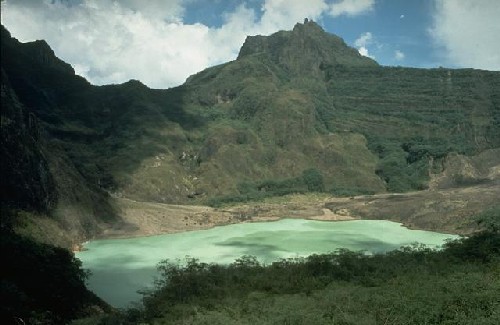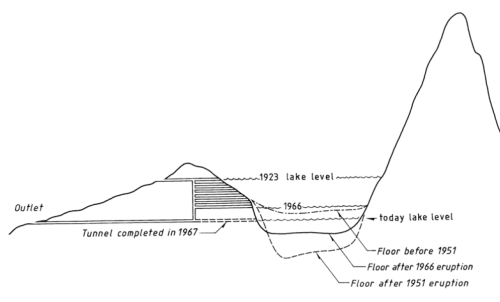Indonesia is certainly not a destination for those wanting the geologically quiet life; its close proximity to a subduction zone is a recipe not just for large, potentially tsunami generating, earthquakes, but also a significant number of explosive volcanoes. Mount Kelud (aka Mount Kelut – I presume this is a transliteration issue as they’re definitely talking about the same volcano) is the current focus of concern for the Center for Volcanology and Geological Hazard Mitigation, who have ordered an evacuation of 30,000 people living around its rumbling crater (pictured below in more tranquil times).

One of the reasons this particular volcano is considered to be so dangerous is its large crater lake. During an eruption, the water within is superheated and explosively ejected from the crater, and mixes with erupted volcanic ash to form devastating mud flows, or lahars. Lahars generated during an eruption in 1919 overwhelmed villages and farmland as far as 40 km from the crater, and killed more than 5000 people.
So here we have another example of people choosing to live within spitting distance of a malevolent geological entity, and refusing to budge even when it is rumbling threateningly at them. What’s interesting in this case, though, is that the Indonesians have apparently been quite proactive in attempting to reduce the threat posed by this particular volcano. Following the 1919 eruption, they set out to cripple Mount Kelud’s lahar-generating ability, by digging a series of tunnels that would drain the crater lake.

After completion in 1926, this drainage system reduced the volume of the crater lake by over 90%, from 40 million cubic metres to less than 2 million. This impressive engineering feat undoubtedly saved countless lives during Kelud’s next big eruption, in 1951: compared to 1919, the lahars produced were severely limited in scope, extending less than 5 km down the volcano’s slopes. Sadly, it was a Phyrric victory: the drainage tunnels were damaged, and material excavated during the eruption had lowered the crater bottom, allowing 20 million cubic metres of water to accumulate inside by the time of the next large eruption in 1966. The resulting lahars were almost back to 1919 levels of destruction, and killed nearly 300 people. The Indonesian authorities learnt from that mistake, however, and by 1967 had dug a new, deeper tunnel, which allowed the crater lake to be drained to its present volume of 2.5 million cubic metres.

It’s a small comfort to know that, thanks to some all-to-rare foresight, the people currently digging in their heels on Kelud’s threatening slopes are a little bit safer than perhaps they would have been.
Sources:
1. Suryo, I and Clarke, MCG. (1985). Quarterly Journal of Engineering Geology and Hydrogeology 18(1), p 79-98.
2. Kelud Volcano. A report from the Commission of Volcanic Lakes.



Comments (10)